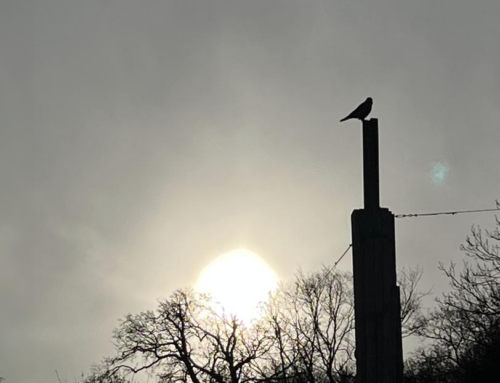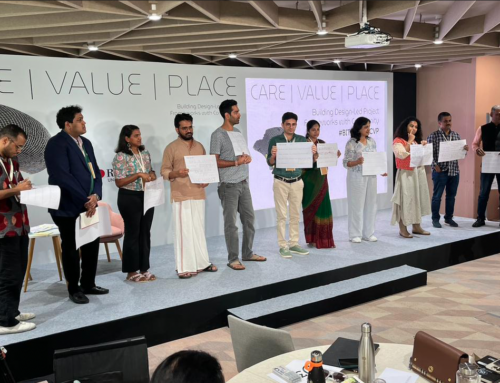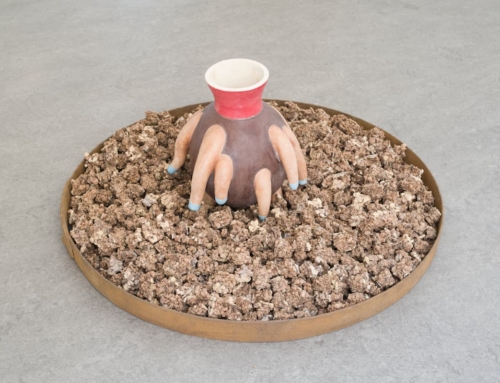The following is a conversation with John Wood, professor at Goldsmiths, University of London, and joint editor (with Julia Lockheart) of the Journal of Writing in Creative Practice. Please cite: Thackara, John (2021), ‘The relationship of texts to dead fish’, Journal of Writing in Creative Practice, 14:1, pp. 5–11, doi: doi.org
Keywords: relational ecology; theory of change; stories; embodied experience; biodiversity; ecosystem; civic ecology; bioregion; design; social fermentation
Abstract John Thackara’s theory of change is borrowed from Ilya Prigogene: ‘when a system is far from equilibrium, small islands of coherence have the capacity to shift the entire system’. As a writer, he explains, his work therefore involves a search for small islands of coherence – that he can later describe – in which social and ecological relationships thrive together. His aim as a curator is similar: he strives to enable embodied encounters with situations (or ‘islands’) in which we feel ourselves to be part of nature, rather than separate from it. This work is therefore not symbolic, like ‘systems thinking’. It is more field work than head work. ‘I want people to experience relational ecologies, not just think about them’, Thackara states. He cites the artist Eva Bakkeslett as describing this process – the cultivation of ecological and social connectivity – as social fermentation.
John Wood (JW): It’s kind of you to spare us some time.You are probably best known in creative circles as a notable editor of Design Magazine and for your informative and highly readable design publications, books like In the Bubble (2006), How to Thrive in the Next Economy (2015) and, of course, your trailblazing ‘Doors of Perception’ conferences. I note that, before dedicating yourself to supporting the design cause, you studied philosophy and journalism. I should explain why I mention this. Although the Journal’s name includes the word ‘writing’, some of us still feel strangely nervous about having to ‘do’ reading or writing. Arguably, quite a lot of artists, designers or craftspeople feel more comfortable hanging around the studio or workshop than they do in the library. So, although the Journal sometimes touches on the use of writing for creative discovery, or as a way to develop theory, I guess it is best at promoting writing that helps artists, craftspeople or designers to clarify their purpose, or to become better practitioners.
John Thackara (JT): Good! I’m not good at talking about abstruse design theory – even though I did study philosophy before starting my first job. In that first job, which was with an architecture publisher, my task was to seek out developments at the edge of the design world and get people to write books about them. Later, when I evolved from being a commissioning editor to being a design critic, and when I was editor of Design, I still didn’t see it as my job to tell designers what to do. Rather, I tried to introduce new conversations that might enrich the practices with which they were engaged. But others saw my work differently. In the early 1980s, one of the founders of Pentagram (the celebrated graphic design company) accused me of stealing the word designer. In retrospect, I’m not unsympathetic to his complaint. These days, the word design has expanded almost to infinity.
JW: That’s a clear explanation of how you navigated what we tend to see as the gaps between practices of writing and design. Did any philosophies, or philosophers, have a strong influence on what you did?
JT: Well, a training in philosophy encourages you to ask why things are as they are, and that habit has persisted. But I don’t want to exaggerate the amount of philosophy I use in my work. The other day I found one of my old university textbooks in a box. Hegel’s Philosophy of Mind. Every second or third line has a heavy notation, made by me as a student. Today, I can barely understand any of it. In my case, philosophy is more of an attitude than a method. I probably owe an apology to professional philosophers, as well as to professional designers – but I just can’t stop asking ‘why?’
JW: It occurs to me that there is a forgotten fault line in design education between, on the one hand, the western tradition of analytical truth-seeking and, on the other hand, the more hands-on practices of creating pictures and forms. These traditions have very different origins, aims and agendas. In the past, the ‘research’ mode sought knowledge that can be explained in written proofs and equations. However, in the art schools of my day, designers tended to be taught just to ‘make things work’, whether aesthetically or practically. Nobody expected us to produce written analysis or justification. In my experience, a high proportion of us were undiagnosed dyslexics, or people who had taught themselves to think in ways that were under the radar practices, I doubt whether universities notice the important chasm that separates the scholastic genres of writing from the way that we encourage creative practitioners to think. Of course, your question ‘why…?’ is familiar not only to philosophers but also to many creative artists, craftspeople and designers. Perhaps, when you have been asking the ‘why’ question, you have also, implicitly, been asking more practical questions, such as ‘how…?’ or, even, ‘how can…?’.
JT: That’s an interesting way to put it. I hadn’t considered that before. Maybe the limitations of writing, as such, have drawn me to people who make and do things in a context, rather than those who reflect upon things in an abstract way. I have learned – belatedly – to respect the work of those you mention: the makers, dyslexics or less-wordy types. I get steadily more nourishment hanging out with local people growing their food, or indigenous people on their lands, or actors and performance artists.
JW: I used to love reading the philosopher Ludwig Wittgenstein, maybe because he was a bit of a designer. After studying engineering, he had the idea of ‘redesigning’ language so that it could communicate without ambiguity or using one word for different purposes. To do this he wanted to make it rational and consistent. He later realised that living beings are complex and impromptu; therefore, our utterances reflect this. However meticulous you are, there will always be aspects that could not be reconciled. I have another question for you. What might have happened, do you think, if your life had been run in a slightly different order? Let’s imagine you started out as an apprentice journalist and then picked up your interest in philosophy afterwards?
JT: That’s an intriguing question. I remember my first day at journalism school in Cardiff. The head of the school, Sir Tom Hopkinson, had hired a no-nonsense former sub-editor from the Glasgow Herald to run the induction course. It was like going to base camp. I can still feel the fear today. This guy said to me, ‘now, laddie, forget all these fancy abstract theories. The most important thing to remember, as a journalist, is that what you write today will be wrapped around the body of a fish tomorrow morning’. My mental equivalent of a dead fish, today, is an Amazon books warehouse. A new book is published every 30 seconds, and that warehouse contains millions of titles. Among them, some- where at the back, are mine. I’ve learned not to worry too much about what happens to my words. They’re out there. That’s enough.
JW: Over the last 50 years or so, universities have increasingly expected artists, designers and craftspeople to accommodate what I would call ‘non-native’ practices of writing. These include the academic protocols of scholarship, such as critical thinking or evidence-based analysis. I am not saying that designers shouldn’t write, but I wonder whether they really have the time to acquire all the skills of a full-time theoretician.
JT: Time, or motivation. When I worked at the Royal College of Art (as director of research), I encountered a strange phenomenon called ‘the thesis’, which was administered by a small Department of Humanities. The written thesis was a torture for many students, but it had acquired the status as a vital part of any design education, even if nobody could quite remember why. I agreed then – and do, now – that it’s important to reflect critically about what we do. But expecting a maker, or a director, or an artist, to sit down on their own and write 10,000 words is not the only way to reflect well.
JW: This makes sense to me. I once spent a year doing my very best to write a book in the very simplest and clearest language possible. My grown-up son has a fine art degree, so I asked him what he thought of it. Yes, he’d enjoyed reading it, he said, but suggested that I just needed to redraft it in a simpler, clearer way. There is a paradox, here. We may see the need for global behavioural change, but human actions are sustained by our ingrained habits. And these, in turn, are shaped by the words and metaphors we happen to have at our disposal. It’s understandable to find readers recoiling from texts that are too difficult, or pseudo-intellectual, but how can ‘creative thinkers’ challenge popular beliefs unless they bother to get inside the language and bend it, or replace it with more useful shapes? Isn’t this why we will always need new or specialist words and concepts that may, at least initially, sound a wee bit pretentious?
JT: I question why artists and designers should be encouraged to write in an intellectual way. That question also applies to specialists of all kinds. After all these years, I still don’t understand the need to converse in abstruse language. For me, experts have a duty to communicate with the rest of us clearly. But too often, they don’t.
JW: Are you saying we need to train more studio practitioners to be popularisers? If visionary artists, designers and craftspeople could communicate more persuasively, would society undergo a swifter paradigm change?
JT: I prefer the word immersion, to persuasion. We need more than one-way communication skills. I attended an event called ‘Transition Anywhere’ in which the Transition Towns movement worked with Encounters Arts. Their special talent is getting diverse groups to talk to one another. They describe their practice as the art of invitation, or the art of hosting.
JW: This chimes with Julia Lockheart’s practical work on co-creative writing. It also reminds me of some of our metadesigners research. We wanted to see if we could turn small, heterogeneous groups of specialist designers into creatively open, non-hierarchical teams (e.g. https://metadesigners.org/Sympoiesis-Glossary). Actually, we started by reinventing some of Meredith Belbin’s management tools based on the identification of ‘team types’.
JT: It’s hard. In workshops with designers, there is often a tension when the people we consider to be the centre of the story, such as farmers, cooks or social activists, feel they are not being listened to. Listening is a practice in itself. It’s been life-changing for me to be working with Annika Göran- Rodell in Sweden. She’s an artist who has also done Theory U training. She designs and curates situations in which everyone feels they are being heard. We might spend, say, fifteen minutes in an ‘active listening’ exercise. It’s not just about silent reflection.
JW: Can we discuss how to deal with aspects of the system that are too complex to describe in words? A lot of designers are suspicious of the way that ‘design thinking’ has become popular. Maybe it’s because they are aware that a lot of knowledge is action-based and embodied. In our metadesign research, several of us received training from the Nowhere Foundation. I don’t know if you know them.
JT: I know of them.
JW: As you probably know, their ‘Systemic Constellations’ workshops came out of Bert Hellinger’s Gestalt psychology theories. Hellinger looked at trauma in people, such as young children, who can’t articulate their feelings in words. He concluded that humans have more knowledge about the social level than at the individual level, but it’s a tacit kind of knowledge. We know more than we think we know, but without the factual details. So he invented a powerful group workshop method that can enable anyone to decode a given social problem, even though they know virtually nothing about the specifics of the particular situation. It all works by getting people to experience standing in the particular physical proximity that matches the problem under review. Humans seem very well attuned to complex emotional relations if they experience them at the physical level, rather than having them described in words. Do you think that our ‘emotional literacy’ might connect with the idea of an ‘ecological literacy’?
JT: I hope so. I’ve spent many years looking for ways to reveal, or teach, ecological literacy – for myself, as much as for the people I work with. I’ve had a number of epiphanal experiences when I felt connected to a more-than-human world. I’ve been taken by people into forests, taken mescaline, spent time with soil scientists, gone on field trips with ecologists. None of these experiences lend themselves to being turned into a course. The best I’ve managed so far is to advocate that we all get out of our lecture rooms and studios and spend time in nature with someone who knows what’s happening there! But I haven’t given up in my search for a designed ecological experience. The software community answered a similar question in their own field – how to interest people in code – by inventing a teaching package called ‘Hour of Code’. It’s a one-hour experience in which small groups experience the fundamentals of coding in a hands-on way. Then, if someone in that group is gripped by it, they’re introduced to a vast amount of online resources. The organisers claim to have reached 20 per cent of all the high school students on the planet – 200 million people or more. I want someone to do the same for ecological literacy.
JW: That’s a great design brief for someone, John. If it’s alright, I’ve got a couple of more questions.
JT: Please, I’m enjoying this.
JW: It occurs to me that there are a few keywords that are critical for change. For studio practitioners, such as designers, these keywords may become either crutches or hurdles, depending on how you see them. Words like ‘growth’ but used in ‘economic growth’ are bandied around in political discourse. Similarly, the adjective ‘sustainable’ is unhelpful to designers or their clients, as it doesn’t say how, who or what should do the sustaining. In 1999, I came up with the word ‘co-sustainment’, but Daniel Wahl’s more recent term ‘regenerative’ is better. It may remind us that we can’t sustain ‘unsustainable’ lifestyles. Why then do people still hang onto the term ‘sustainable?’
JT: I agree with you that the word sustainable can feel like a millstone around our necks. But it’s not just about finding a better word. What many people connect with are stories and ideally direct experiences. These stories should be about grassroots innovators, movers and shakers who often don’t know or care what the word ‘sustainable’ means. That said, there’s still one word I cannot ignore, the word ‘growth’. I spent years wagging my finger at people and telling them that growth is evil. Eventually, I noticed that most people tend to blank out when I started that particular rant. So I changed tack. These days I look for examples of ‘good’ growth – growth in the health of places, growth in the health of living organisms, growth in biodiversity. People also liven up when we discuss how living systems are present in unexpected places, such as weeds in cities. They say, ‘oh, really – so going back to nature isn’t just about going and living in a tepee on some damp hill?’
My theory of change is borrowed from Ilya Prigogene: ‘when a system is far from equilibrium, small islands of coherence have the capacity to shift the entire system’. As a writer, my work involves a search for small islands of coherence – that I can later describe – in which social and ecological relationships thrive together. My aim as an event curator or teacher or workshop organizer is similar. I strive to enable embodied encounters with situations (or ‘islands’) in which we feel ourselves to be part of nature, rather than separate from it. These islands are my ‘studio’.
This work is not symbolic, like ‘systems thinking’. It’s more field work than head work. I want people to experience relational ecologies not just think about them. The artist Eva Bakkeslett describes this process – the cultivation of ecological and social connectivity using embodied experience – as social fermentation.
JW: Thank you, John. It’s been a pleasure.





